Synchronizing Your Media
If you chose to let iTunes manage synchronizing your data automatically, welcome back. This section looks at how you get your media — your ringtones, music, movies, TV shows, podcasts, video, iTunes U courses, books, and photos — from your computer to your iPhone.
Sharp-eyed readers may notice that we aren’t covering syncing iPhone apps in this chapter. Apps are so darn cool that we’ve given them an entire chapter, namely Chapter 15. In that chapter, you discover how to find, sync, rearrange, review, and delete apps, and much, much more.
That said, if you buy or download any of the following items on your iPhone, the item will be copied back to your computer automatically when you sync:
![]() Songs
Songs
![]() Podcasts
Podcasts
![]() Videos
Videos
![]() iBooks, e-books, and audiobooks
iBooks, e-books, and audiobooks
![]() Apps
Apps
![]() Playlists that you create on your iPhone
Playlists that you create on your iPhone
And if you save pictures from e-mail messages, from the iPhone camera, from web pages (by pressing and holding down on an image and then tapping the Save Image button), or from screen shots (by pressing the Home and Sleep/Wake buttons simultaneously), these too can be synced.
You use the Apps, Tones, Music, Podcasts, Movies, TV Shows, iTunes U, Books, and Photos panes to specify the media that you want to copy from your computer to your iPhone. The following sections explain the options you find in each pane.
To view any of these panes, make sure that your iPhone is still selected in the sidebar and then click the appropriate button near the top of the window.
The following sections focus only on syncing. Need help acquiring apps, music, movies, podcasts, or anything else for your iPhone? This book contains chapters dedicated to each of these topics. Just flip to the most applicable chapter for help.
Ringtones, music, movies, and TV shows
You use the Tones, Music, Movies, TV Shows, Podcasts, and iTunes U panes to specify the media that you want to copy from your computer to your iPhone. To view any of these panes, make sure that your iPhone is still selected in the source list, and then click the appropriate tab near the top of the window.
Ringtones
If you have custom ringtones in your iTunes library, select the Sync Ringtones check box in the Tones pane. Then you can choose either all ringtones or individual ringtones by selecting their check boxes. Ringtones can be used also as text tones and alarms.
Music, music videos, and voice memos
To transfer music to your iPhone, select the Sync Music check box in the Music pane. You can then select the option for Entire Music Library or Selected Playlists, Artists, and Genres. If you choose the latter, click the check boxes next to particular playlists, artists, and genres you want to transfer. You also can choose to include music videos or voice memos or both by selecting the appropriate check boxes at the top of the pane (see Figure 3-7).
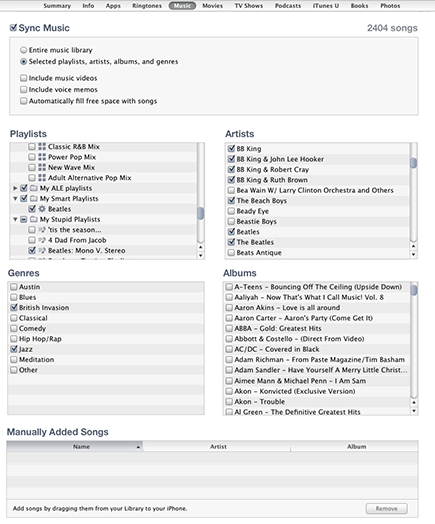
Figure 3-7: Use the Music pane to copy music, music videos, and voice memos from your computer to your iPhone.
If none of the options just mentioned sounds just right (pun intended), you can drag individual songs onto the Manually Added Songs section near the bottom of the Music pane, as you see at the bottom of Figure 3-7.
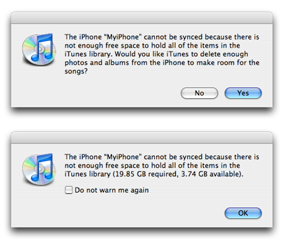
Figure 3-8: If you have more music than your iPhone has room for, this is what you’ll see when you sync.
Finally, if you select the Automatically Fill Free Space with Songs check box, iTunes fills any free space on your iPhone with music.
Movies
To transfer movies to your iPhone, select the Sync Movies check box and then choose an option for movies you want to include automatically from the pop-up menu, as shown in Figure 3-9. If you choose an option other than All, you can optionally select individual movies and playlists by checking the boxes in appropriate sections.
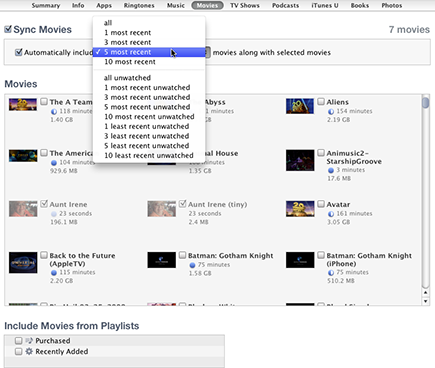
Figure 3-9: Your choices in the Movies pane determine which movies are copied to your iPhone.
TV shows
The procedure for syncing TV shows is slightly different from the procedure for syncing movies. First, select the Sync TV Shows check box to enable TV show syncing. Then choose how many episodes to include and whether you want all shows or only selected shows from the two pop-up menus, as shown in Figure 3-10. If you want to also include individual episodes or episodes on playlists, select the appropriate check boxes in the Shows, Episodes, and Include Episodes from Playlists sections of the TV Shows pane.
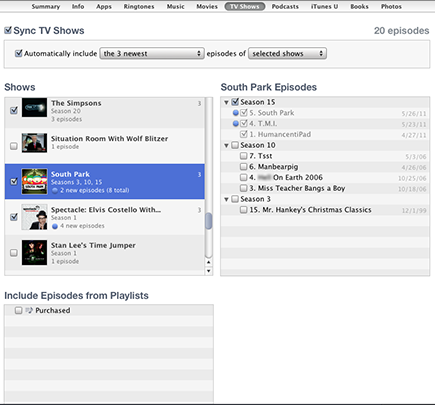
Figure 3-10: The TV Shows pane determines how TV shows are synced with your iPhone
Podcasts, iTunes U, and books
You can also sync podcasts, educational content from iTunes U, two types of books — e-books for reading and audiobooks for listening — and photos.
Podcasts
To transfer podcasts to your iPhone, select the Sync Podcasts check box in the Podcasts pane. Then you can automatically include however many podcasts you want by making selections from the two pop-up menus, as shown in Figure 3-11. If you have podcast episodes on playlists, you can include them by selecting the appropriate check box in the Include Episodes from Playlists section.
iTunes U
To sync educational content from iTunes U, first select the Sync iTunes U check box to enable iTunes U syncing. Then choose how many episodes to include and whether you want all collections or only selected collections from the two pop-up menus. If you want to also include individual items or items on playlists, select the appropriate check boxes in the Items section and Include Items from Playlists section of the iTunes U pane.

Figure 3-11: The Podcasts pane determines which podcasts are copied to your iPhone.
Books
By now we’re sure you know the drill: You can sync all your e-books or audiobooks or just sync selected titles by choosing the appropriate buttons and check boxes in the Books pane.
Photos
Syncing photos is a little different from syncing other media because your iPhone has a built-in camera — two cameras, actually — and you may want to copy pictures or videos you take with the iPhone to your computer, as well as copy pictures stored on your computer to your iPhone.
The iPhone syncs photos and videos, too, with the following programs:
![]() Mac: Aperture version 3.2 or later or iPhoto version 9.2 or later
Mac: Aperture version 3.2 or later or iPhoto version 9.2 or later
![]() PC: Adobe Photoshop Elements or Adobe Photoshop Album
PC: Adobe Photoshop Elements or Adobe Photoshop Album
You can also sync photos with any folder on your computer that contains images.
In the Photos pane, select the Sync Photos From check box, and then choose an application or folder from the pop-up menu (which says Aperture in Figure 3-12).
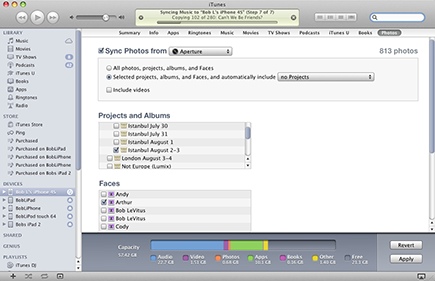
Figure 3-12: The Photos pane determines which photos will be synchronized with your iPhone.
If you choose an application that supports photo albums (such as Photoshop Elements, Aperture, or iPhoto), projects (Aperture), events (iPhoto), facial recognition and Places (Aperture or iPhoto), or any combination thereof, you can automatically include recent projects (Aperture), events (iPhoto), or faces (Aperture and iPhoto) by making a selection from the same pop-up menu (refer to Figure 3-12).
If you choose a folder full of images, you can create subfolders inside it that will appear as albums on your iPhone. But if you choose an application that doesn’t support albums or events, or a single folder full of images with no subfolders, you have to transfer all or nothing.
Because we selected Aperture in the Sync Photos From menu, and Aperture 3 (the version installed on our Mac) supports projects and faces in addition to albums and photos, we have the option of syncing any combination of photos, projects, albums, and faces.
If you’ve taken any photos with your iPhone or saved images from a web page, an e-mail, an MMS message, or an iMessage since the last time you synced, the appropriate program launches (or the appropriate folder is selected), and you have the option of uploading the pictures to your computer.
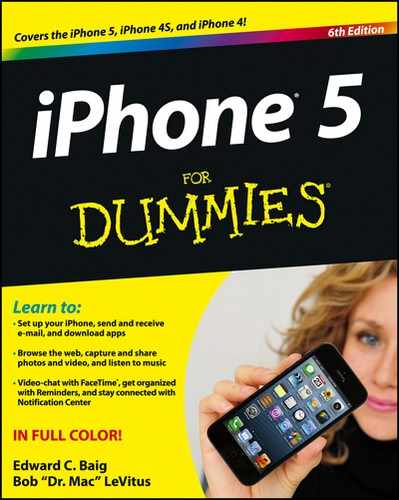
 Podcasts and videos (but not photos) from your computer are synced only one way: from your computer to your iPhone. If you delete a podcast or a video that got onto your iPhone via syncing, the podcast or video will not be deleted from your computer when you sync.
Podcasts and videos (but not photos) from your computer are synced only one way: from your computer to your iPhone. If you delete a podcast or a video that got onto your iPhone via syncing, the podcast or video will not be deleted from your computer when you sync.
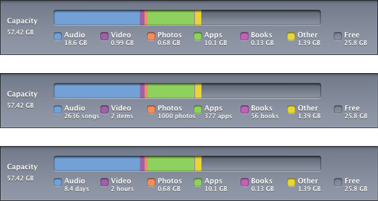
 If you choose Entire Music Library and have more songs in your iTunes library than storage space on your iPhone, you’ll see one or both of the error messages shown in Figure 3-8 when you try to sync. You’ll also see a yellow alert on the right side of the Capacity chart at the bottom of the screen, along with how much over your iPhone’s capacity adding the entire music library would make you. To avoid such errors, select playlists, artists, and genres that total less than the free space on your iPhone, which is also displayed in the Capacity chart at the bottom of the iTunes screen.
If you choose Entire Music Library and have more songs in your iTunes library than storage space on your iPhone, you’ll see one or both of the error messages shown in Figure 3-8 when you try to sync. You’ll also see a yellow alert on the right side of the Capacity chart at the bottom of the screen, along with how much over your iPhone’s capacity adding the entire music library would make you. To avoid such errors, select playlists, artists, and genres that total less than the free space on your iPhone, which is also displayed in the Capacity chart at the bottom of the iTunes screen.